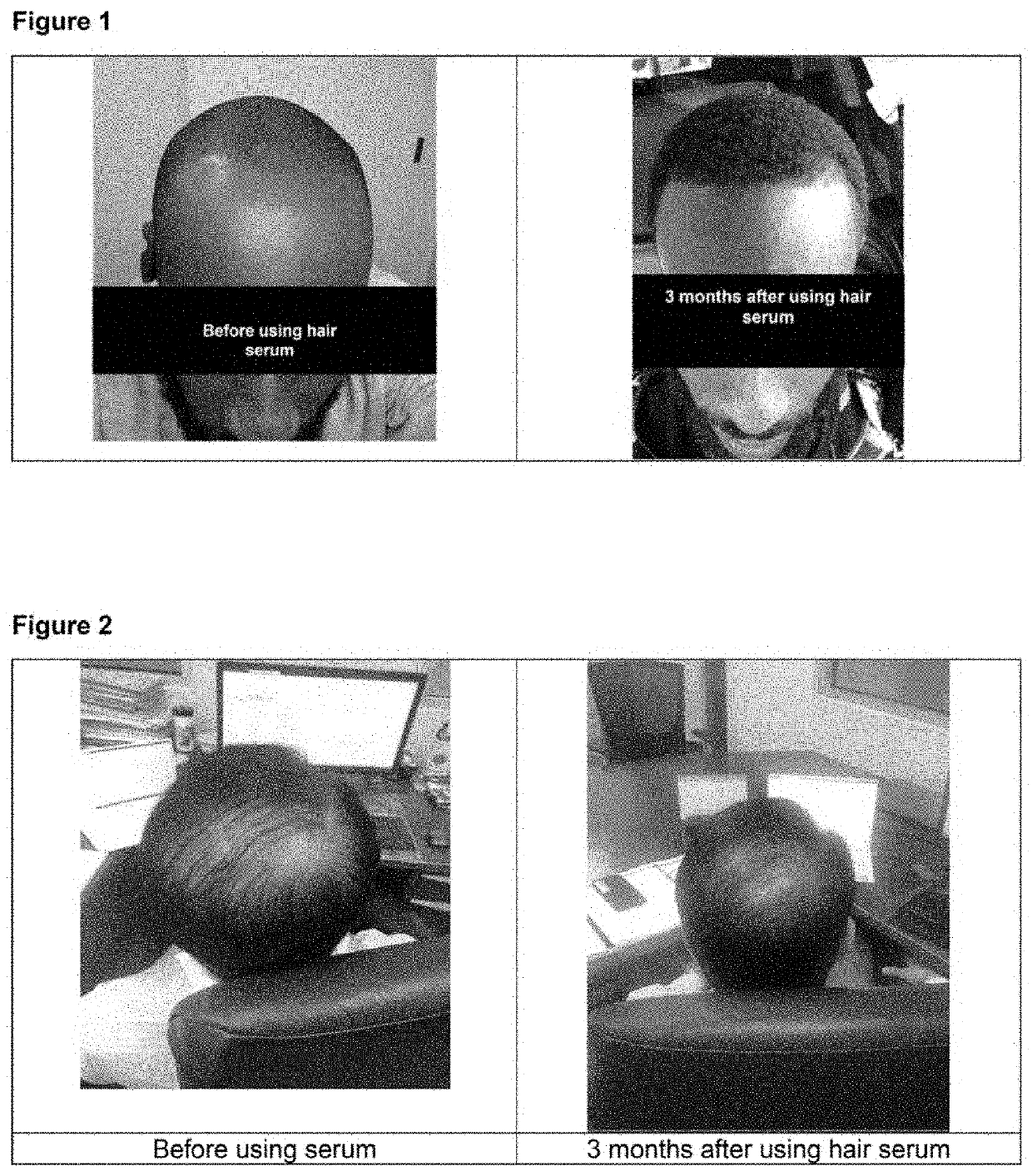Compositions and methods for reducing hair loss and increasing hair growth
a technology applied in the field of compositions and methods for reducing hair loss and increasing hair growth, can solve the problems of hair strand loss at any time, devastating effect on one's quality of life and mental health, and loss of the majority of hair strands, so as to promote hair growth, fuller looking head, and counteract hair loss and/or thinning
- Summary
- Abstract
- Description
- Claims
- Application Information
AI Technical Summary
Benefits of technology
Problems solved by technology
Method used
Image
Examples
example 1
[0082]A scalp serum (Composition 1) according to the present teaching was prepared having the composition as presented in Table 2.
TABLE 2Composition 1INCI nameTrade Name / Supplier% w / wPhase AWater 62.15PanthenolRitapan DL, 50% / Rita 1.00NiacinamideNiacinamide / DSM 1.00Denatured AlcoholDenatured / Alcohol / 15.00Quality ChemicalPolyquaternium-10Ritaquta 3000 / Rita 0.75Butylene GlycolJeechem Bugl / Jeen 4.00GlycerinGlycerin / Jeen 3.00Dehydroacetic Acid & BenzylGeogard 221 / Lonza 1.00AlcoholTrisodium EthylenediamineNatrlquest E30 / Innospec 0.10DisuccinatePhase BEthoxydiglycolTranscutol CG / Gattefosse 8.00Acetyl Zingerone (Compound 1)Synoxyl ® AZ / Sytheon / 2.00Present inventionRasberry Ketone (Compound 12)Synoxyl ® RK / Sytheon / 2.00Present inventionTotal100.00
[0083]Composition 1 was prepared by weighing each of the components of Phase A and combining them in a main kettle equipped with a homogenizer and heating, while mixing, to 50-55° C. Similarly, each of the components of Phase B were wei...
example 2
[0084]A second scalp serum (Composition 2) according to the present teaching was prepared having the composition as presented in Table 3, Composition 2A having Acetyl Zingerone (Compound 1) and Composition 2B having Methyl Acetyl Zingerone (Compound 11). These compositions were prepared according to the same procedure as Composition 1.
TABLE 3Compositions 2A and 2BINCI nameTrade Name / Supplier% w / wPhase AWater 64.15PanthenolRitapan DL, 50% / Rita 1.00NiacinamideNiacinamide / DSM 1.00Polyquaternium-10Ritaquta 3000 / Rita 0.75Butylene GlycolJeechem Bugl / Jeen 4.00GlycerinGlycerin / Jeen 3.00Water & Sodium Benzoate &Euxyl K 712 / Schulke 1.00Potassium SorbatePhase BEthoxydiglycolTranscutol CG / Gattefosse 23.00Acetyl Zingerone (Compound 1)Synoxyl ® AZ / Sytheon / Present 2.00 ororinvention or 2.00Methyl Acetyl ZingeroneSynoxyl ®(Compound 11)inventionMAZ / Sytheon / PresentTotal100.00
example 3
[0085]An evaluation of the compositions according to the present teaching were applied to three male subjects to evaluate their effect in promoting hair growth and rejuvenation as follows:[0086]Composition 1 was applied to the scalp of an African American individual (44 yrs. old male) twice a day for three months. He had been experiencing hair loss and had been bald for the last five years. He shows receding hairline on the front of the head and loss of hair on the crown of the head. He doesn't have any underlying skin conditions like eczema. Prior to the application of the Composition 1, the individual had applied Rogaine for a period of four months, but failed to see any growth. When using both Rogain and Composition simultaneously, significant hair growth and thickening was manifest as shown in FIG. 1.[0087]Composition 2A was applied to the scalp of an Asian American individual (75 year old male) twice a day for three months. As shown in FIG. 2, a significant improvement in hair ...
PUM
| Property | Measurement | Unit |
|---|---|---|
| pH | aaaaa | aaaaa |
| area | aaaaa | aaaaa |
| length | aaaaa | aaaaa |
Abstract
Description
Claims
Application Information
 Login to View More
Login to View More - R&D Engineer
- R&D Manager
- IP Professional
- Industry Leading Data Capabilities
- Powerful AI technology
- Patent DNA Extraction
Browse by: Latest US Patents, China's latest patents, Technical Efficacy Thesaurus, Application Domain, Technology Topic, Popular Technical Reports.
© 2024 PatSnap. All rights reserved.Legal|Privacy policy|Modern Slavery Act Transparency Statement|Sitemap|About US| Contact US: help@patsnap.com










